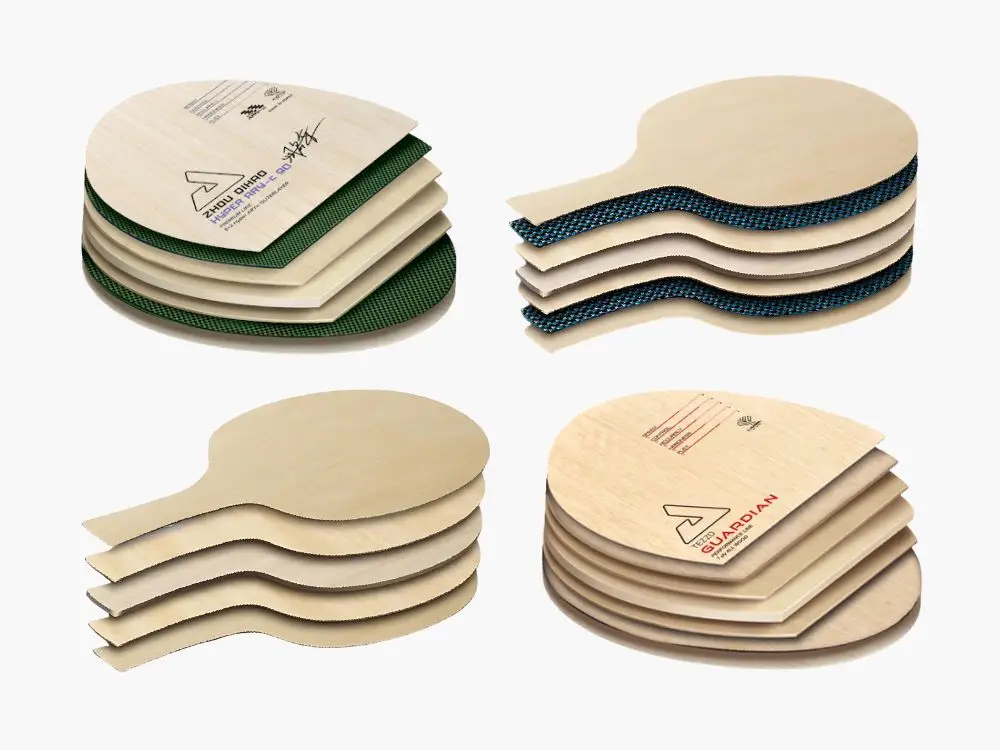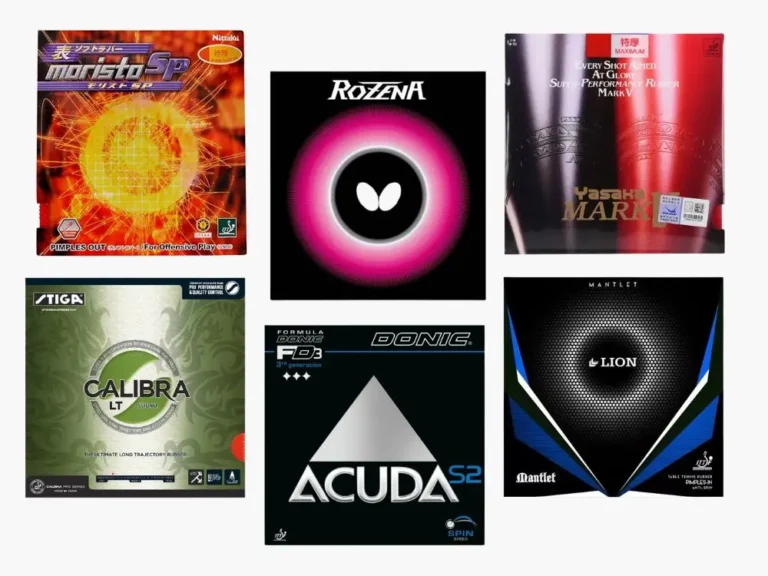The blade is the “engine” of your table tennis racket, providing the foundation for speed, control, and feel. While the rubber often gets most of the attention, the blade’s construction, specifically its composition, plays a crucial role in shaping your game. From classic all-wood designs to modern composite innovations, understanding the differences between 5-ply, 7-ply, and carbon blades is essential for every player looking to optimize their equipment.
This detailed guide will break down the characteristics, advantages, and ideal playing styles for each blade type, helping you choose the perfect foundation for your table tennis journey.
The Foundation: Understanding Blade Composition
A table tennis blade is not a solid piece of wood. Instead, it’s crafted from multiple layers, or “plies,” of wood veneer, meticulously glued together. In composite blades, layers of materials such as carbon, aramid, or fiberglass are integrated between or outside the wood plies. Each ply, its thickness, the type of wood used, and the overall construction method contribute to the blade’s unique playing characteristics.
The primary attributes affected by blade composition include:
- Speed: How fast the ball rebounds off the blade.
- Control: Your ability to accurately place the ball and manage incoming spin.
- Feel (Dwell Time): How long the ball “dwells” on the blade, influencing spin generation and touch.
- Sweet Spot: The optimal area on the blade face where shots feel consistent and powerful.
- Stiffness/Flexibility: How much the blade bends upon impact, affecting trajectory and feel.
Let’s explore the three most common categories:
5-Ply All-Wood Blades: The Classic All-Rounder
The 5-ply all-wood blade is often considered the standard and a timeless favorite for its balanced characteristics.
Composition:
Typically made from five layers of wood veneer, commonly limba, kiri, or ayous. The central core is usually thicker, flanked by thinner cross-grain layers, and finished with outer face veneers.
Characteristics:
- Control: Excellent control due to good dwell time and relatively lower speed. This allows players to feel the ball well and place it accurately.
- Feel & Dwell Time: Offers a soft, “woody” feel with significant dwell time. The ball sinks into the rubber and wood slightly, enabling players to impart a lot of spin.
- Speed: Generally offers medium to medium-low speed. While not as explosive as composite blades, they provide sufficient power for controlled attacking.
- Sweet Spot: A decent sweet spot, but less forgiving than composite blades.
- Flexibility: More flexible than 7-ply or carbon blades, contributing to a higher arc on loops.
Ideal For:
- Beginners and Developing Players: Helps in learning proper stroke mechanics and developing a sense of the ball.
- All-Around Players: Excels in a balanced game that emphasizes consistency, spin, and strategic placement.
- Loopers: The extended dwell time is fantastic for generating heavy topspin.
- Defensive Players: Provides the control needed for chopping, pushing, and consistent returns.
Examples: Sauer Tröger Dominate All, Andro Novacell OFF, Sauer Tröger Firestarter.
7-Ply All-Wood Blades: The Offensive Workhorse
Stepping up in speed and directness, 7-ply all-wood blades offer more power while still retaining a good sense of feel.
Composition:
Constructed from seven layers of wood veneer, often with a thicker core and more layers compared to 5-ply. The increased number of layers contributes to greater stiffness.
Characteristics:
- Speed: Significantly faster than 5-ply blades, providing more offensive power for drives and smashes.
- Control: Still offers good control, though slightly less dwell time than 5-ply. Requires a bit more precision.
- Feel & Dwell Time: Provides a more direct feel than 5-ply, with less dwell time. The ball comes off the blade quicker.
- Sweet Spot: A slightly larger sweet spot than 5-ply, leading to more consistent, powerful shots.
- Stiffness: Generally stiffer, resulting in a flatter trajectory for attacking shots.
Ideal For:
- Offensive All-Around Players: Those who seek a balance between powerful attacks and controlled rallies.
- Hitters & Smashers: The increased speed makes it easier to finish points with direct hits.
- Mid-Distance Loopers: Provides sufficient power for strong loops from further away from the table.
- Players Transitioning to More Offensive Play: A good step up from a 5-ply without going straight to composite.
Examples: Stiga Nostalgic VII, Andro Timber 7 OFF/S, Sauer Tröger Black&White.
Carbon Blades (Composite Blades): The Modern Powerhouse
Carbon blades and other composite variations represent the modern evolution of blade design, prioritizing speed and a large sweet spot.
Composition:
These blades integrate layers of composite materials (most commonly carbon, but also aramid, Zylon, fiberglass, etc.) with wood plies.
- Outer Carbon (e.g., Treiber CO structure): The carbon layers are closer to the surface, providing a harder, more direct feel, higher speed, and a larger sweet spot. Examples: Andro Treiber CO OFF/S, Andro Synteliac ZCO.
- Inner Carbon (e.g., Synteliac VCI structure): The carbon layers are placed closer to the core, offering a softer feel, more dwell time than outer carbon, but still more speed than all-wood blades. Examples: Andro Synteliac VCI, Andro Treiber CI OFF.
Characteristics:
- Speed: Extremely fast and powerful, ideal for aggressive attacking play. Composite materials enhance rebound properties.
- Control: Generally less control than all-wood blades due to reduced dwell time. It can be challenging for beginners or those who prefer a touch-oriented game.
- Feel & Dwell Time: A very direct, often “crisp” feel with minimal dwell time. The ball springs off quickly.
- Sweet Spot: Significantly larger sweet spot, making off-center hits feel more consistent and powerful.
- Stiffness: Very stiff, resulting in a flatter, more direct ball trajectory.
Ideal For:
- Aggressive Attackers (Loop & Smash): Players who focus on overpowering opponents with sheer speed and spin.
- Counter-Loopers: The high speed and large sweet spot are excellent for powerful counter-attacks.
- Players Seeking Maximum Power: Those who want every bit of speed they can get from their blade.
Examples: Butterfly Viscaria, Butterfly Timo Boll ALC, Stiga Carbonado series.
Comparison at a Glance
| Feature | 5-Ply All-Wood | 7-Ply All-Wood | Carbon (Composite) |
|---|---|---|---|
| Composition | 5 wood layers | 7 wood layers | Wood + Composite (e.g., Carbon, ALC) layers |
| Speed | Medium to Medium-Low | Medium to Medium-High | High to Very High |
| Control | Excellent | Good | Lower (more demanding) |
| Feel | Soft, Woody, High Dwell Time | Direct, Moderate Dwell Time | Crisp, Direct, Low Dwell Time |
| Sweet Spot | Standard | Slightly larger | Significantly Larger |
| Stiffness | Flexible | Stiffer | Very Stif |
| Arc | High | Medium | Flatter |
| Ideal For | Beginners, All-Rounders, Loopers, Defensive | Offensive All-Rounders, Hitters, Mid-Distance Loop | Aggressive Attackers, Counter-Loopers, Smashers |
Choosing the Right Blade for You
Selecting the perfect blade involves a holistic consideration of several factors:
Your Playing Style:
- Control-oriented (Defensive/All-Round): Prioritize 5-ply blades for feel and consistency.
- Balanced Offensive (All-Round Attack): A 7-ply or inner-carbon blade offers a great blend of power and control.
- Aggressive Offensive (Attacker): Carbon blades (especially outer carbon) will provide the raw speed needed.
Your Skill Level:
- Beginner: Start with a 5-ply all-wood blade. It’s forgiving and allows you to develop fundamental strokes.
- Intermediate: You can explore faster 5-ply options, 7-ply, or inner-carbon blades as your technique improves.
- Advanced: You’ll have a clear understanding of your needs and can fine-tune your choice among 7-ply and various carbon blades.
Your Rubber Choice:
- A fast blade paired with fast rubbers can be overwhelming.
- A slower blade might benefit from faster rubbers to add pace.
- Consider the overall balance of your setup.
Budget:
Blade prices vary significantly. All-wood blades are generally more affordable, while high-performance carbon blades can be quite expensive.
Personal Feel:
Ultimately, the best blade is the one that feels right in your hand and complements your strokes. If possible, try out different blades before committing to a purchase.
The blade is the backbone of your table tennis racket, and its composition profoundly impacts your game. Whether you opt for the nuanced feel and control of a classic 5-ply all-wood blade, the balanced aggression of a 7-ply, or the explosive power of a modern carbon composite, an informed choice will lay the groundwork for optimal performance. Take the time to understand your own playing style and skill level, and select a blade that truly empowers your game.
Frequently Asked Questions (FAQs)
For beginners, a **5-ply all-wood blade** is generally recommended. They offer excellent control, good dwell time for learning spin, and are more forgiving, allowing new players to focus on developing proper technique without being overwhelmed by excessive speed.
Many professional players do use carbon or other composite blades due to their high speed, large sweet spot, and direct feel, which suit their aggressive attacking styles. However, some professionals still prefer 7-ply or even certain 5-ply all-wood blades for their specific feel and control characteristics.
“Dwell time” refers to the brief moment the ball stays in contact with the rubber and blade during a shot. It’s crucial because longer dwell time allows the player more time to impart spin on the ball. All-wood blades (especially 5-ply) typically offer more dwell time, which is beneficial for looping and touch shots.
While you can physically attach any rubber to any blade, optimal performance comes from a balanced setup. Pairing a very fast carbon blade with very fast rubbers might be uncontrollable for many players. A slower blade might benefit from faster rubbers, or vice-versa, to achieve your desired balance of speed, spin, and control.
In “outer carbon” constructions (e.g., Butterfly Viscaria), the carbon layers are placed directly under the top wood plies. This results in a harder, more direct feel, higher speed, and a larger sweet spot. In “inner carbon” constructions (e.g., Butterfly Innerforce), the carbon layers are closer to the core of the blade, offering a softer feel and more dwell time, while still providing enhanced speed compared to all-wood blades.
Stiffer blades (like most 7-ply and carbon blades) tend to produce a flatter, more direct ball trajectory and higher speed, as less energy is lost in blade flex. More flexible blades (like 5-ply all-wood) will typically produce a higher arc on loops due to increased dwell time and “spring” from the flex, which can offer more safety over the net.


